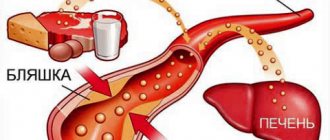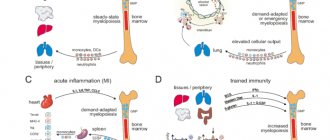Increased phosphorus: causes and consequences
The condition of the body in which the phosphate content in the blood increases (more than 1.45 mmol/l) is called hyperphosphatemia. The reasons for the increase in the amount of inorganic phosphorus in the blood are as follows:
- disruption of the process of phosphate excretion by the kidneys, which may be associated with renal failure;
- long-term intake of food or medications high in this macronutrient;
- development of malignant tumors;
- tumor disintegration after chemotherapy;
- destruction of muscle tissue due to injury;
- healing of bones after a fracture;
- overdose of vitamin D in the body.
An increase in the amount of phosphorus leads to its deposition not only in bones, but also in other organs. As a result, changes occur in the muscles, as well as disturbances in the functioning of the kidneys, nervous system, and heart. Simultaneously with the analysis for phosphorus, it is necessary to determine the level of calcium in the blood, since these two elements are directly interrelated.
Indications for the study
It is recommended to take a blood test for phosphorus in the following cases:
- various pathologies of bone tissue;
- dysfunction of the parathyroid glands;
- chronic kidney problems;
- abnormal vitamin D levels.
If deviations from the norm are minor, clinical manifestations are usually absent. To obtain a more complete picture of the patient's condition, phosphorus and calcium levels are usually determined simultaneously. The results of these two analyzes make it possible to reliably assess the state of mineral metabolism.
It is also recommended to undergo examination if you have the following symptoms:
- muscle spasms or weakness;
- fatigue, constant fatigue;
- repeated fractures with minor impact on the bones.
The norm of phosphorus in the blood of children, women, men
The level of phosphorus in the blood varies significantly throughout life , this is explained by the fact that phosphorus plays a huge role in the formation of internal tissues and organs, especially in the growth of bone mass and teeth.
For this reason, in children it is at maximum values, and then begins to gradually decrease and reaches minimum values in old age.
It should also be noted that phosphorus in the blood can decrease or, on the contrary, increase during the day , this is due to the different intensity of a person’s motor and mental activity during the day.
In women, the value of this mineral is about 0.9-1.5 mmol/l (900-1500 mg in the body), and during pregnancy and lactation it can reach 3800 mg. After reaching 60 years of age, the norm is approximately 0.90-1.32 mg.
In men, the indicators are also approximately 0.81-1.45 (900-1500 mg). After reaching 60 years of age, they decrease to 0.75-1.2.
Infants and children up to 24 months - 1.19-2.78 mmol/l. Fluctuations in phosphorus content in the body range from 1200 to 2500 mg. In infancy, these values are maximum. Children under 12 years old - 1.45-1.78
What are the dangers of deviations from the norm?
Significant fluctuations in phosphorus are the cause of vascular accidents
With an excessive concentration of P in the body, metabolism is disrupted, the most common consequence is the leaching of calcium from the bones. Damage to bone tissue is accompanied by tooth destruction and frequent bone fractures. In this case, calcium moves into the bloodstream, which leads to the formation of calcium deposits in the vessels. This condition provokes the development of cardiovascular pathology, in particular, coronary heart disease and heart failure.
The consequences of hyperphosphatemia are damage to the intestines and liver, and deposition of stones in the kidneys. Characterized by a decrease in the number of leukocytes and the development of anemia. The body's protective functions decrease, cases of infectious diseases become more frequent, and spontaneous hemorrhages may occur. An increase in P levels in the blood increases the risk of heart attack and death from cardiovascular pathologies.
Impaired sensitivity - consequences of phosphorus deviations
Hypophosphatemia in infants leads to the formation of rickets, a disruption of bone growth processes. The immune system, both in children and adults, is not able to provide full protection of the body, since the functions of leukocytes are impaired. Efficiency and concentration decrease, the nervous system undergoes changes - apathy alternates with increased excitability and irritability. There may be a decrease in sensitivity to the point of numbness of the skin or excessive sensitivity to cold or touching the skin.
The process of muscle contraction, including the heart muscle, is disrupted. There is a negative impact of phosphorus deficiency on the overall metabolism of the body and acid-base balance.
In severe forms of phosphorus deficiency, brain damage occurs, which can lead to coma and death.
Normal content in the body
Each age and gender will have its own norm of this element in the body.
- Blood cholesterol levels - table by age. Cholesterol in the blood - norms for women, men and children
Among women
In the female body system up to 60 years of age, the composition of phosphorus as a whole does not differ from that of the male body.
Attention! Normally it is 0.87–1.45 mmol/l.
But after 60 years of age, test data will change. During this period, changes occur in women, and the norm of this element will be 0.9–1.32 mmol/l.
In men
Young and middle-aged men (up to 60 years of age) have an average phosphorus level of 0.87–1.45 mmol/l. After 60 years – 0.74–1.2 mmol/l.
In children
Children under 2 years of age have a phosphorus norm of 1.45–2.16 mmol/l.
From 2 years to 12 years – 1.45–1.78 mmol/l.
And after 12 years of age, data on the amount of phosphorus in the blood are equal to adults, that is, they will be equal to 0.87–1.45 mmol/l.
In pregnant women
The normal phosphorus level in pregnant women will depend on the trimester:
- The norm for the first trimester of pregnancy is considered to be a phosphorus level of 1.0-1.57 mmol/l.
- In the second trimester, the level of this substance decreases and will be equal to 1.0-1.4 mmol/l.
- In the third trimester, the norm of phosphorus in the blood is 0.87-0.47 mmol/l.
Important! When going for tests to determine the amount of phosphorus, you should know that the indicator of this substance can vary depending on many factors. Even within a day, the amount of phosphorus will vary.
If, for example, a person was engaged in physical exercise, then the analysis will show a completely different figure than at rest.
- What are triglycerides, normal levels, reasons for the increase, how to reduce
References
- Simerville, J., Maxted, W., Pahira, J. Urinalysis: a comprehensive review. Am Fam Physician., 2005. - Vol. 71(6). - P. 1153-62.
- Chernecky, C., Berger, B. et al. Laboratory Tests and Diagnostic Procedures. Saunder Elsevier, 2008.
- Fauci, A., Ksper, D., Longo, E. et al. Harrison's principles of internal medicine. The McGraw-Hill Companies, 2008.
- Pettifor, J. What's new in hypophosphataemic rickets? Eur J Pediatr., 2008. - Vol. 167(5). - P. 493-9.
- Wolf, M. Forging forward with 10 burning questions on FGF23 in kidney disease. J AmSocNephrol., 2010. - Vol. 21(9). - P. 1427-35.
Importance of this indicator
Reference. Phosphorus is a chemical substance that, according to its characteristics, belongs to semimetals and interacts extensively with other substances in the human body. It can exhibit the qualities of both an oxidizing agent and a reducing agent.
Phosphorus is a valuable element in ensuring the healthy and full functioning of the entire body, maintaining optimal metabolism and balance of all systems and internal processes. The chemical element P can be found in almost any cell.
Particularly large amounts of this compound are found in the brain, muscles, but especially in teeth and bones. The blood contains inorganic phosphorus.
In its absence, a person in reality will not be able to move, think, or breathe freely.
Functions of phosphorus:
- necessary for the formation of healthy teeth and bone tissue (80-85% of all phosphorus is located there);
- ensures proper functioning of the heart and kidneys;
- important for the nervous system, as it participates in the transmission of nerve impulses;
- one of the elements of nucleic acids that are responsible for growth, cell division, as well as storage and reproduction of genetic information;
- participates in the process of muscle work;
- influences the processes of accumulation and release of energy from cells;
- helps to release glucose from products through oxidation in chemical reactions;
- in large quantities it is necessary for serious physical, mental and psycho-emotional stress.
Low content
Often, a decrease in phosphate in the blood occurs even with sufficient dietary intake. A reduced content of this mineral is considered dangerous. This phenomenon is associated with:
- metabolic disorders;
- dysfunction of the excretory system;
- various poisonings, including from harmful foods and drinks;
- dysfunction of the parathyroid gland.
Symptoms of P deficiency usually manifest as abnormalities in the muscular and nervous systems. Appears:
- muscle cramps, bone pain;
- changes in skin sensations;
- heart and lung failure;
- anxiety, irritability, apathy;
- loss of appetite.
With a prolonged lack of phosphorus, a dangerous disease appears - hypophosphatemia. Then it is likely that the symptoms will worsen and the following will appear:
- vomiting, diarrhea;
- bleeding gums, softening of bones, their fragility;
- abnormalities in the central nervous system;
- heart failure.
What does a urine test show?
A urine test to determine the amount of phosphorus may be prescribed for some painful conditions:
- The analysis is carried out if it is impossible to establish an accurate diagnosis for hyperphosphatemia; this could be renal failure, hypoparathyroidism, tumor lysis syndrome, etc. It is also carried out for hypophosphatemia, suspected hyperparathyroidism, Fanconi syndrome, etc.
- To prevent excess vitamin D and rickets in children.
- To detect nephrolithiasis.
Symptoms of hyperphosphatemia
In some cases, a completely asymptomatic course of this condition is possible. Clinical manifestations are mainly related to hypocalcemia. Due to increased neuromuscular conductivity, muscle cramps and spasms occur. Some patients complain of paresthesia (tingling sensation, crawling sensations) of the limbs.
Due to weakening of vascular tone and cardiac output, blood pressure decreases - the patient may experience dizziness, a feeling of increased and rapid heartbeat. Clinical signs of hypocalcemia are much more pronounced if the cause of hyperphosphatemia is chronic renal failure or hypoparathyroidism. Calcification of soft tissues causes itching of the skin and joint pain, aggravated by movement. Hard subcutaneous nodules form in the area of the projection of the joints.
Interference:
- Anabolic steroids, androgens, beta-blockers (eg, acebutol, pindolol), estrogens, ergocalciferol, furosemide, growth hormone, hydrochlorothiazide, methicillin (for nephrotoxicity), phosphates, sodium etidronate, tetracycline (for nephrotoxicity).
- Acetazolamide, albuterol, aluminum-containing antacids, amino acids, anesthetics, calcitonin, carbamazepine, adrenaline, estramustine, fructose, glucocorticoids, glucose, hydrochlorothiazide (long-term use), phosphamide, insulin, isoniazid, oral contraceptives, phenytoin, sucralfate.
Diagnostics
Since the leading cause of hyperphosphatemia is terminal chronic renal failure, patients with this electrolyte disorder are most often under the supervision of nephrologists. During a general examination of the patient, attention is paid to traces of scratching on the skin, the presence of subcutaneous nodes that are hard on palpation, and identification of signs of hidden tetany - Trousseau and Chvostek symptoms.
Help in recognizing this condition is provided by anamnestic information - diagnosed chronic renal failure, surgery on the thyroid or parathyroid glands. The level of phosphorus is examined in the serum using a biochemical analysis. Differential diagnosis is carried out to establish the etiological factor. For this, as well as to confirm the diagnosis, the following examination is prescribed:
- Laboratory research
. In a biochemical blood test, an increase in the concentration of urea and creatinine is often noted, and almost always a decrease in the level of ionized calcium; less often, a shift in pH to the acidic side. For kidney diseases, the glomerular filtration rate is calculated. - Screening for primary hypoparathyroidism.
In patients, a decrease in the content of parathyroid hormone is detected in the blood, and increased excretion of calcium in the urine. Ultrasound reveals atrophy or absence of the parathyroid glands. Testing for genetic forms of hypoparathyroidism may be needed. - Densitometry.
Osteodensitometry (DEXA) shows a decrease in bone mineral density (T-score from -1.0 and below). - Echography.
Ultrasound of the kidneys in some patients reveals stones in the renal pelvis. Ultrasound of the periarticular tissues shows calcifications. - CT scan.
CT scans of the brain can sometimes visualize calcifications in the basal ganglia. - ECG.
With severe hypocalcemia, the electrocardiogram reveals a prolongation of the QT interval and tachycardia of the “pirouette” type.
Ultrasound of the parathyroid glands










